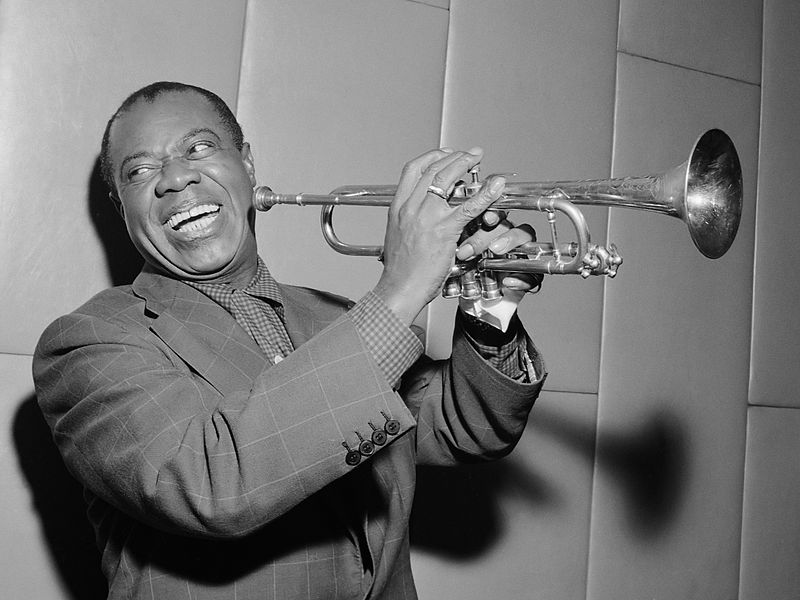Honoring a Jazz Lengend: Profile on Louis Armstrong
Armstrong was born in New Orleans, Louisiana, to a low-income household in the rough neighborhood of the Battlefield, where he spent the majority of his youth. Armstrong’s father, William, left the family for another woman when he was an infant. Later, Armstrong’s mother also left to become a prostitute, putting him and his younger sister in the care of his grandmother when he was five years old.
Armstrong’s first introduction to music was at the Fisk School for Boys at the age of six, but his main exposure came from hanging around dance halls whenever he got the chance. The dance hall Armstrong frequented most was Pete Lala’s, where he would watch Joe “King” Oliver, a famous American jazz cornet player and bandleader who would later become his close mentor.
Although Armstrong tried all he could–working as a paperboy, finding discarded food and selling it to restaurants, hauling coal to the red-light district Storyville–he couldn’t manage to get his mother out of prostitution. At the age of seven, Armstrong worked hauling around junk for a Lithuanian-Jewish family, who took him in as their own. Armstrong saw that the Jewish family was also subject to Southern discrimination and wore a Star of David pendant for the rest of his life to honor them. Armstrong dropped out of the Fisk School at the age of eleven and joined a quartet of boys who sang for money in attempts to support his family.
In 1912, Armstrong was enlisted at the New Orleans Home for Colored Waifs because one night he shot his step-father’s rifle into the air during a New Year’s Eve celebration and was arrested. While there, Professor Peter Davis provided him with trumpet and cornet lessons. Armstrong did so well that he was placed as the school’s band leader a little later. Once let out of the home in 1914, Armstrong knew his calling was in music and kept honing his skills by playing in the city’s brass band parades and listening to older musicians. Although Armstrong experienced strife growing up, he recalled growing up in New Orleans with great affinity, describing how, “Everytime I close my eyes blowing that trumpet of mine – I look right into the heart of good old New Orleans… it has given me something to live for.”
Armstrong’s formal career in jazz began a little later, in the 1920s, when his mentor Oliver resigned his position in Kid Ory’s band and had Armstrong replace him.Throughout the next decades, Armstrong’s popularity would continue to rise. After moving between several cities (from New Orleans to Chicago and Chicago to New York), he decided to settle back in Chicago where he began recording under his own name instead of under an orchestra or a band. He produced hits “Potato Hot Blues,” “Muggles,” and “West End Blues,” which would set the stage for jazz players in the coming years. During Armstrong’s time producing music, he also became a vocalist and helped define the art of jazz singing with his invention of scat: an improvised jazz singing where the voice is used to imitate an instrument.
Armstrong was the first jazz musician to write an autobiography, Satchmo: My LIfe in New Orleans, published in 1954, where he talks about the discrimination he experienced in the 1920s. Armstrong’s autobiography highlights how jazz brought communities of black and white together despite the era’s laws of segreegation. In 1936, Armstrong became the first black person to be featured on a billboard for a major Hollywood movie, Pennies from Heaven. Armstrong would go on to star in over a dozen different films including Paris Blues, Cabin in the Sky, and Hello Dolly!
Although not much of a political activist, Armstrong voiced his disapproval of segregation at Little Rock in 1957 when he called President Eisenhower “two-faced” and “gutless” for his nonchalant attitude toward the event. The event was one of the only times Armstrong is cited as having stood up for civil rights, which at the time made many African-Americans disapprove of the artist.
He is remembered today for revolutionizing jazz music, introducing influences from a variety of sources to change the rhythm of jazz in that era. Because of Armstrong’s trumpet skills, the instrument emerged as a solo instrument, revolutionizing jazz from collective improvisation to solo performing. He won his first and only Grammy in 1964 for Male Vocal Performance for his song, “Hello, Dolly!”, which had unseated the Beatles from number one in the charts. In 1972, Armstrong was posthumously awarded the Grammy Lifetime Achievement Award because of his creative contributions and artistic significance. He was inducted into the Rock and Roll Hall of Fame as an early influence in 1990.
Famous musicians such as Billie Holiday and Frank Sinatra believe themselves indebted to Armstrong. Duke Ellington said, “if anybody was a master, it was Louis Armstrong.” Many edifices have been renamed to honor the legend: the airport in New Orleans is now called Louis Armstrong New Orleans Airport and several museums have been founded in his honor, such as the Louis Armstrong House Museum in Corona, Queens. Although currently under reconstruction, The Louis Armstrong Stadium is the second largest stadium in the USTA Billie Jean King National Tennis Center where part of U.S. Open takes place annually. Armstrong is remembered today as a legend, with unmatched talent and creativity used to shape the jazz, rock and roll, and folk music we listen to today.

